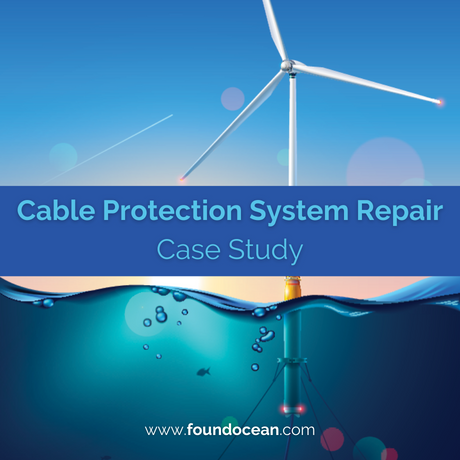
Cable Protection System Repair Case Study
Our Sales Director, Andy Venn, talks about a recent project where FoundOcean is helping to repair a wind farm substation that had been damaged by erosion, using our new biodegradable formwork bags.
The Impact of Scour on Offshore Infrastructure
Erosion can impact subsea infrastructure, and one especially common example is scour. The seabed is constantly being changed and reshaped by currents, tides and storms which move sand and sediment from one place to another. This means that erosion can occur at the base of a structure, or around a cable, and cause stress points leading to a it being less protected and more susceptible to damage.
In the North Sea, the site of a great number of the world’s offshore wind farms, much of the surface of the seabed is sandy, which means it can easily be stirred up and displaced. As a result, protective measures need to be in place, and the places where cables rise up from the seabed to the structure – known as free span – are encased in a Cable Protection System (CPS). This ‘extra layer’ of casing protects the free span cables at their most exposed point against abrasion or impact.
Repairing Damage to a Cable Protection System
We have recently been helping the operators of an offshore wind farm where it had experienced more scour than expected. This was beginning to cause damage, especially around the substation. As part of their routine maintenance, the site has annual inspections using ROVs to scan the area and capture images of any erosion.
On the free span part of this structure, more sand had washed away than in previous years or as had been initially predicted in pre-construction site surveys, meaning that now some cables were not protected as fully as they needed to be.
The substation is the heart of the wind farm, connecting the cables bringing energy from the turbine strings into the substation and feeding it to the energy companies onshore. The cables therefore needed to be stabilised as a matter of urgency, to prevent any further disrepair so that and the substation could continue to deliver power.
The operators acted extremely quickly and asked FoundOcean to bring their expertise to this problem. They also wanted to discuss a solution that could be plastic-free … more on that in a moment!
We started working on the two most damaged cables, to stabilise them on the seabed and allow for the damaged Cable Protection System to be repaired. We installed 2 wedge-shaped fabric formworks, to enable three things:
- support the J-tube cables
- even out the dip in the seabed caused by scour
- allow more CPS to be added
To carry out this work, the wind turbines were switched off and earthed. Then the cables were raised, and our fabric formworks were put into position; our grout was pumped through hoses into the formwork bags, then the cables were lowered back into place.
Even during the process, we could respond quickly to a developing situation. As the team filled the formworks, they could see that a cable was going to start sinking into the seabed because of the heaviness of the grout. We were able to be adaptable and discuss the required adjustments, recalculate, and continue the work, correcting the issue and supporting this repair project most effectively.
With the scour damage on the two most-impacted cables now addressed, the project is ongoing to ensure that all the cables on this wind farm can be stabilised and any early signs of CPS damage repaired.
Plastic-free Biodegradable Formwork Bags
This project was particularly significant for FoundOcean, as it is the first time we have installed our new, biodegradable formwork bags.
Standard formwork bags are composed of a woven polypropylene blend for flexibility, permeability and durability.
After testing materials for robustness, we have developed a greener alternative: fabric formworks made from natural fibres.
Developing formwork bags that do not risk microplastics getting into the water is important for protecting underwater ecosystems and is currently a hot topic internationally. In March, at the UNEA (United Nations Environment Assembly) in Nairobi, the Roundtable on Marine Litter (RTM) highlighted the importance of ‘reducing the open use of plastics in the marine/coastal environment (eg: geotextiles, corrosion protection of offshore installations)’.
Recent legislation in Germany echoes this sentiment. In August of this year, Germany joined the international High Ambition Coalition to End Plastic Pollution by 2040. New rulings that will affect all wind farms in German waters, say that companies must minimise plastic use on infrastructure in the water that could be liable to degradation and lead to microplastics getting into the water.
According to the Federal Ministry for the Environment, Nature Conservation, Nuclear Safety and Consumer Protection, the plastic volumes found in rivers and lakes are expected to more than triple between 2019 and 2060. In the same period, the volumes in oceans could increase fivefold, from 30 to 145 million tonnes. For this reason, it is incredibly important to address microplastics in our waters, and to find and utilise greener solutions.
We will continue to offer all FoundOcean customers – not just those with structures in German waters – the opportunity to install biodegradable fabric formworks in upcoming projects. As well as the all-too-obvious benefits to the planet and all who live on it, this will also be a huge help to businesses for their Environment, Sustainability and Governance (ESG) aspirations.
For more information on FoundOcean’s experience and capabilities, contact the team on +44 1506 440330 or email info@foundocean.com
